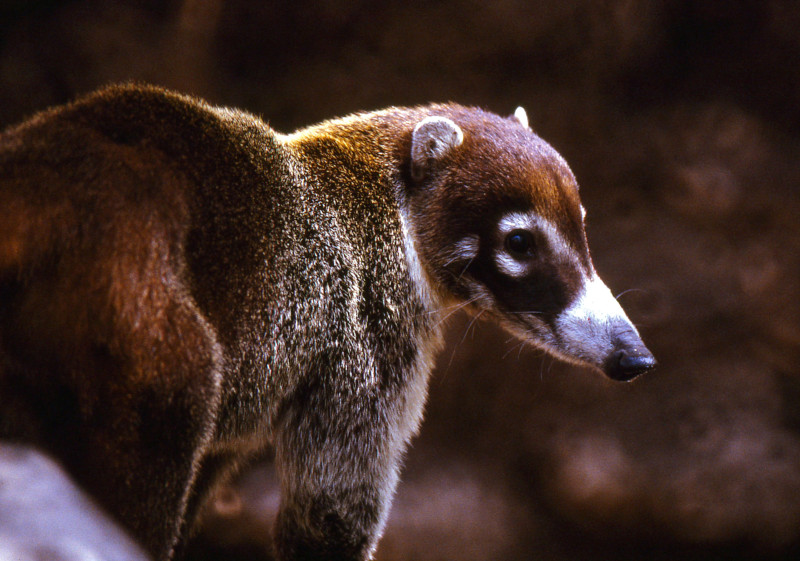White-Nosed Coati Facts
- This remarkable mammal is frequently referred to by the common name of the White-nosed Coati, by those individuals who know of it. The amazing creature also has yet another common name, though. That’s because some people refer to it by the name of the coatimundi.
- In the primary language of the section of the world in which this marvel of Nature appears, however, it’s referred to by several other common names, however. Those include the varying terms antoon, the pizote, and the tejón, depending upon the individual’s exact local region.
- Researchers, meanwhile, typically refer to the awesome animal by its formal scientific name. That’s the relatively easy to pronounce term, as such things go, of the Nasua narica. By either title one chooses to use to refer to it, the animal remains a truly fascinating species.
- The unique animal received that formal name at the hands of Carl Linnaeus himself. The highly esteemed Swedish zoologist accomplished the first formal acknowledgement of it as a separate and distinct species. He achieved that scientifically noteworthy deed in the year 1776.
- Fortunately, both for it and those who appreciate the marvels of Nature, the species seems to be maintaining a population base that continues to be both sizeable and stable. That situation also appears to hold true thoughout the entirety of its known natural zone of habitation.
- Due to this situation, the IUCN currently lists the White-nosed Coati as Least Concern on its Red List of Threatened Species. Given the nature of its habitat, though, the mammal could face threats in the future. These include habitat loss and the looming threat of climate change.
Related Articles
White-Nosed Coati Physical Description
Scientists classify the magnificent White-Nosed Coati as a member of the Procyonidae family, actually making it a relative of the raccoon. Due to that relationship, the marvelous mammal shares many attributes with the raccoon, both physically and in terms of its general behavior.
Physically, however, it displays a larger degree of the physiological characteristic of sexual dimorphism than most of its known relatives. In the case of this specific species, that trait manifests itself in terms of sheer physical size, with the genders displaying the same basic coloring.
More specifically, the males of this fascinating species attain a significantly larger average size than their female counterparts. That’s due to the fact that individuals of this gender weigh as much as 27 lb (12.2 kg). The smaller females, meanwhile, frequently weigh as little as 5.5 lb (2.5 kg).
It’s also well known for its somewhat over-sized tail. Between the two genders, an average body length equals roughly 1.5 – 2 ft (0.46 – 0.91 m). The remarkable tail, though, typically measures around 2 ft (0.91 m) itself! The combination gives the mammal an extremely recognizable look.
The visually memorable creature also possesses relatively long, sharp claws, small ears, and an elongated snout. This feature further tilts up at the end. Both genders evolved a black mask, with white showing around the nose, eyes, and inside the ears. Its fur has a brownish background.
Mixed in with the brownish fur of the captivating White-Nosed Coati develops a mixture of yellow and red on the upper side of the animal. Underneath, though, it displays a notably lighter brown shade. The tops of its feet and lower legs, meanwhile, usually develop as brownish-black in color.
- Kingdom: Animalia
- Phylum: Chordata
- Class: Mammalia
- Order: Carnivora
- Family: Procyanidae
- Genus: Nasua
- Species: N. narica
White-Nosed Coati Distribution, Habitat, and Ecology
Fortunately for it, the amazing White-Nosed Coati evolved as native to a comparatively extensive swathe of the surface of the globe. That’s because the mammal appears in a zone of habitation that includes Central America, as well as portions of both North America and South America, too.
That natural range extends as far north as the states of New Mexico and Arizona, within the borders of the United States. The southern portion of that range, however, extends all the way to the country of Colombia. There, it appears in the northwestern region, near the border with Panama.
A small population of the wonder, however, also appears in the state of Florida. Experts, however, consider that population grouping to be an artificially introduced one. The time frame for that introduction remains uncertain, though the earliest recorded sight happened in 1928.
This species displays a decided preference for inhabiting wooded areas. This includes both moist and dry forests. It further appears to not discriminate in terms of altitude. That’s due to the fact that specimens appear at heights ranging from around sea level to as high as 9,800 ft (3,000 m).
The White-Nosed Coati evolved as fully omnivorous in terms of its feeding habits. The prickly pear ranks as one of its favorite foods. Otherwise, the flexible animal consumes a rather wide range of prey. This includes varieties of ants, termites, spiders, grubs, beetles, and even scorpions!
It also employs its comparatively long, powerful claws to dig into the soil for underground prey. These consist of a wide range of species, including lizrads, rodents, nuts, fruits, snakes, and on occasion carrion. It’s truly opportunistic, showing no great preference, other than the prickly pear.
It also evolved to be mostly active in the daylight hours. Males generally remain solitary in nature, while females and their young generally move about in packs. These sometimes even number as many as 40 individuals. It’s also both a strong swimmer and climber, usually sleping in trees.
Species Sharing Its Range
Check out our other articles on 3 Tantalizing Tasmanian Animals, Spiny Dogfish, Salton Sea, California red-sided garter snake, Flying Duck Orchid, 5 Stunning Pacific Ocean Sharks

